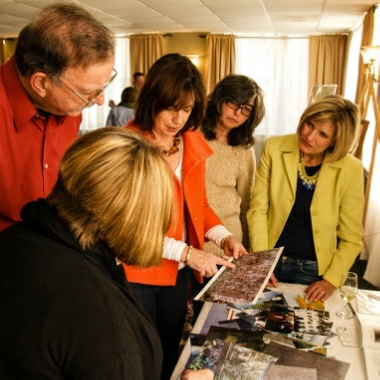Constructing an Irish family tree poses particular challenges. First, there’s the dearth of written records. Not only were the most fruitful life events—birth, marriage, death—not recorded until 1864, many of those records were lost to fire during Ireland’s 1922 Civil War and to other calamities (including being pulped to support war effort in World War I).
And in many Irish-American families, roots run deep and wide. Siblings were separated, by oceans or land, as they sought new opportunities. For some, contact became sporadic and eventually faded to black. The prejudice the new immigrants encountered in America propelled them to quickly shed their Irishness and with their self-imposed rapid Americanization, family histories were lost in the silence. For modern family historians, those roots remain hidden from view, sometimes forever, sometimes until some fate intervenes.
In the 21st century, fate uses social media: You suddenly come across photos of your great grandparents on flickr.com or read familiar names in a post on a genealogy page on Facebook that you stumbled upon.
It was social media that finally brought the roots of Marianne MacDonald’s mother’s family, the Murphys of Tuosist, Collorus Point, County Kerry, to the surface, and a couple of weeks ago, she gathered about a dozen long-lost cousins from Florida, Tennessee, New York, and North Jersey at the Commodore Barry Club (The Irish Center) in Philadelphia where they shared their separate “bits and pieces” of family history.
Including letters from the girls their Great-Aunt Peggie met when she lived for a time in Ireland with an aunt, after the death of her mother. And photos of the Murphy headstones in Tuosist, some barely legible, that cousin Ellen Dyal of Jacksonville, Florida, took when she was in Ireland last year.
It was when Dyal was preparing for her trip, her second, that she came across a Facebook page dedicated to Tuosist, the parish on the scenic Beara Peninsula where the Murphy clan lived. There, she saw Marianne MacDonald’s post seeking information about her grandmother, Julia, Peggie Murphy’s sister. And the sister of Dyal’s grandfather, Patrick.
“I read it and thought, oh my God, my sister had just given me a piece of paper with a lot of the family names and Julia’s name was on it,” says Dyal. “I realized that she was the sister of my grandfather, Patrick Murphy. I tried to message Marianne and Facebook told me it would cost me $1 to send a message to her since I didn’t know her and I decided to pay the dollar. Five minutes later I heard from her. ‘Oh my God, we’re cousins!’”
The two got on the phone and talked for an hour and a half. MacDonald, a special education teacher from Mantua, NJ, who hosts the “Come West Along the Road” Irish radio hour every Sunday on WTMR, 80 FM, was able to hook Dyal up with people in Tuosist she met during her many trips back who knew the Murphy family. That included the postmistress, Maureen O’ Sullivan, who helped Dyal find the family home, a large, rambling house on secluded wooded point that had been vacant for many years before being turned into a holiday home. “She even remembered my grandfather going back every year,” says Dyal.
During her last trip, MacDonald says, she spent two hours talking to O’Sullivan whose prodigious memory turned up another cousin, Ed Murphy of Monmouth County, NJ, who attended the Philadelphia reunion. “She said to me, there was another Murphy here a couple of years ago and she pulled out a big ledger, and there was his address and phone number, so I called him.”
It turned out that their paths had likely crossed before. “We started talking and realized that we had been at the same Irish events at the same time,” says MacDonald, laughing. They just don’t remember meeting.
That wasn’t the only coincidence these Murphy descendants uncovered. When MacDonald was looking for her grandmother on the 1930 US Census, she discovered that Dyal’s grandfather, Patrick Murphy, was rooming with her grandparents in New York. And Ellen found a letter from her grandfather, written after MacDonald’s grandmother’s death, saying, Julia, had been his “favorite sister.”
The family lost touch for many reasons. For one, there were 10 children scattered all over, some across the country, others in Ireland and England. There’s no information on two of the siblings at all. Dyal’s mother married a man named Shapiro and was, for a time, ostracized by the family for marrying out of the Catholic faith. Her grandfather, Patrick Murphy, had only daughters, so their Murphy line was subsumed by other family names.
Not all the Murphys could make the Philadelphia reunion, including Kevin, whom MacDonald met via email several years ago after he saw her photos from Collarus Point on flickr.com, a photo storage site.
But they’re planning another one. “We were all so thrilled to meet each other—it was the best thing eve,” says MacDonald, “so we’re thinking of going to Ireland next spring. Ellen is in touch with the cousins in England, so they may come.”
In Irish genealogy circles, that’s what’s known as a sublimely happy ending.
See our photos of the Murphy Family Reunion.

